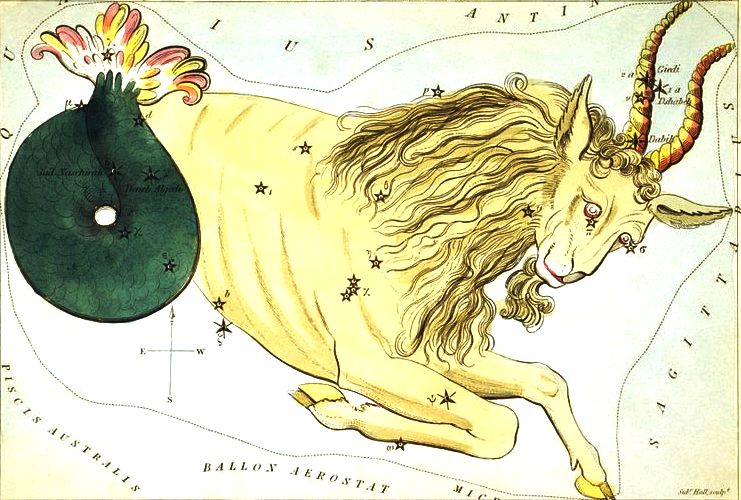 MERMAIDS: Beauty and the Beast in the German Heroic Sagas by Peter Krüger ©2015 [Germanic Astronomy] |
I’d like to start my investigation with a look on the German poem Wolfdietrich, preserved in several variants:
“The tale of Wolfdietrich is connected with the Merovingian princes, Theodoric and Theodebert, the son and grandson of Clovis. Wolfdietrich is the son of Hugdietrich, emperor of Constantinople. The account of his parents and their wooing, however, differs in various texts. Rejected and abandoned by his father, the child is spared by wolves and raised by the noble Berchtung of Meran. After the emperor's death, Wolfdietrich is driven from his rightful inheritance by his brothers at the instigation of the traitor Sabene. Berchtung and his sixteen sons stand by Wolfdietrich. Six of them are slain and the other ten imprisoned. Only after a long exile in Lombardy at the court of King Ortnit can the hero return to deliver the captives and regain his kingdom.”
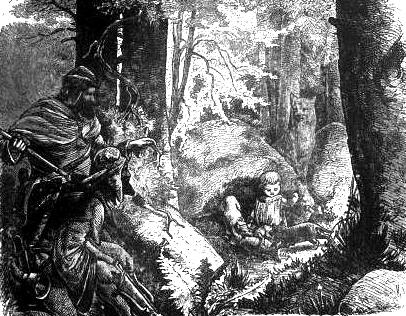
Young Wolfdietrich spared by the wolves
In another variant, Wolfdietrich A, the eponymous hero refuses to marry her. She shows him the way to the land Lamparten and Garden, the castle of Ortnit, then disappears from the story. Interestingly, Garden is located at a lake, the Gartsee. There Wolfdietrich meets Liebgart. the widow of King Ortnit. Remarkably, he hears her crying before he sees her: vnnd ein küniginne vil jammerlichen klagen. This groups her among the damsel-in-distress type ladies whose prototype is Andromeda, normally depicted as being chained to rocks. In a historical context, Garden is often associated with Garda in upper Italy near Lake Garda in Lombardy, but in an astral context, Garden can also be connected with the Great Square of Pegasus as I have argued in another post. Thus, at this point in the story, we find a confluence of two different tales, leading to a duplication of the place (the Square) and the beautiful woman (Andromeda).
Many scholars have been puzzled by this episode and have referred to it as appearing rather ‘unmotivated’ in the story – however, assuming an astral origin would smoothly explain why it appears exactly at this point of the story:
The mermaid shows Wolfdietrich the way to Garden, the castle of King Ortnit. There he meets the widow of King Ortnit (Andromeda) and rides out to avenge King Ortnit (Orion) by killing the dragon (Serpens) living in the hollow mountain. After entering the hollow mountain, he encounters a lion fighting with a dragon. This detail too can be easily explained by star lore. After entering the hollow mountain behind the Milky Way, he meets the constellation Leo, the Lion, fighting Hydra, the serpent/worm/dragon.
 |

The Raue Else in Wolfdietrich D
Again, the story starts with the escape of Wolfdietrich from the realm of his two treacherous brothers, along with his palatine Berchtung and his sons. While keeping watch during the night, a wild woman (‘ruhe wip’) approaches him, walking on all fours like a bear (‘also sie wer ein ber’). She immediately asks him to marry her, but he refuses. Enraged, she casts a spell on him, then steals his sword and horse. In a second encounter, he finds her sleeping beneath a tree, and asks her for his sword and horse back. Again, he refuses to marry her and again he is hit by a spell, causing him to go mad and wander alone half a year through the forest. In the meantime Berchtung who suspects that Wolfdietrich was abducted by Else, comes to her realm beyond the wild sea (‘uber den wilden se’) and to her castle called the Old Troy, ‘alten Troye’. She denies keeping Wolfdietrich and Berchtung leaves.
Later an angel comes to Else and demands that she release Wolfdietrich from his madness or else die. She lifts the spell from him and asks him a third time to marry her, claiming that she is so ugly because her stepmother had cursed her. She then takes him to her realm, Old Troy. There, she jumps into a fountain of youth (‘junkbrunnen’) and suddenly turns into a beautiful woman named Sigewinne/Sigeminne ‘die schönste über alle lant’, the fairest in all the land. Her old ugly skin ‘die ruhe hut’ is stripped off in the water. Upon seeing this, Wolfdietrich himself jumps into the fountain and becomes a handsome young man again.
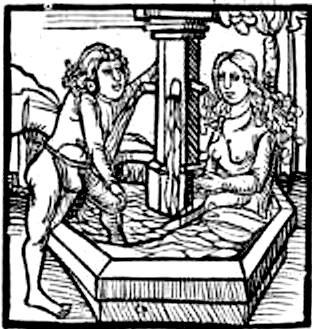
Wolfdietrich and raue Else in the Fountain of Youth Woodcut from a mss. of Deutsches Heldenbuch |
Can the details of this story be explained in astronomical terms?
Wolfdietrich’s first encounter with Else may refer to the constellation Lupus, also called Fera, the Beast. The second encounter below the tree (Milky Way) may refer to Capricorn, the Goat-fish, even if a detailed description is missing. Else has stolen the sword of Wolfdietrich (the stinger of Scorpio) and his horse (horse part of Sagittarius). Now it’s getting especially interesting: The fountain of youth, I would associate with the water pouring out of the urn of Aquarius (i.e. Wolfdietrich is depicted as Aquarius. This will be play an important role later in the discussion of Brynhild.)
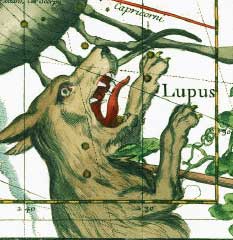 |
 |
 |
Sigeminne is Andromeda and Old Troy, the Great Square of Pegasus. The wicked stepmother could be a reference to Cassiopeia, the mother of Andromeda, who is also responsible for her daughter’s distress. Wolfdietrich at the side of Sigeminne surely refers to the constellation Perseus.
Later on, Sigeminne is abducted by a giant named Tresian (Trisian, Drisigon, Trusian Y). Therefore she is the same type of lady-in-distress as Andromeda threatened by Cetus. Wolfdietrich rescues her from the giant, who is described later as the typical “gigantic doorkeeper with an iron pole”, an Orion-like character. Wolfdietrich fights against him in front of his mountain called Altenfelse.
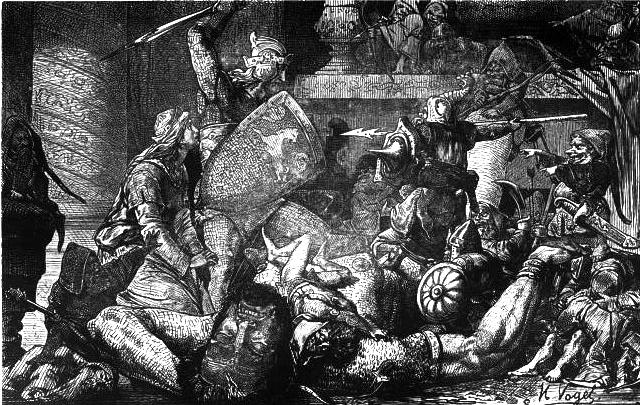 Wolfdietrich battles the doorkeeper and his dwarfs |
|
“Ich fand vor einem berge einen risen
freisan, |
I
found in front of a mountain a frightening giant which belonged to old Tresian* With his iron pole he approached me But god in heaven helped me gain the victory. This happened in front of a mountain that was hollow inside, which was full of dwarfs and evil villains. They ignited sulphur, pitch and resin, spoke Otnit the emperor, thereof I got black. |
*An echo of Tresian can also be found in Thidrekssaga as Drusian, the previously deceased king of Drekanflis, a father of nine maidens like the sea-giant Aegir and the Van-lord Njörd (See Sólarljóð 79).
Afterwards Wolfdietrich has to kill the sister of Tresian called Berille (Parilla in Y, Scorpio?). The whole scene could be compared with the fight of Dietrich and Hildebrand with the giants Grim and his sister Hild. In Germanic mythological texts, such battles between gods and giants occur frequently.
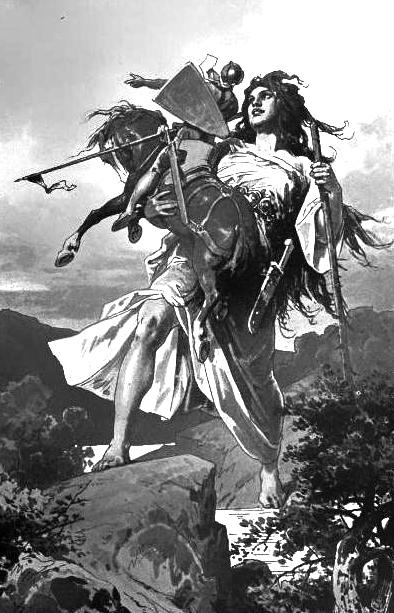
Wolfdietrich and the giant's sister
Part 3:
The Babehilt Episode in Eckenlied E2
In the first two parts of this series, I investigated the mermaid-episodes in two different versions of Wolfdietrich. We find a similar story about a ‘lady of the sea’ named Babehilt in the medieval German poem Eckenlied variant E2 (‘Donaueschingen’) (verses 151-160).
Dietrich meets her immediately after the defeat of the giant Ecke in a landscape described as having meadows ( ‘ovwen’) and a splendid fountain (‘bi ainem brunnen wunnesan’) beneath a large liden tree (‘under ainer linden brait’). He dismounts from his horse Falke and ties him to a branch of the linden tree.
The woman is described as being very beautiful, (‘vrovwe zart’, ‘raine’, ‘minneclich gestalt’, 'tugentriche)’ and a queen. After his fight with the giant Ecke, Dietrich is near death (‘won ich bin nahe tot’). Babehilt cares for his wounds and gives him a box containing a healing balm, (‘ain búhs mit salben’).
She explains to him that her name is Babehilt
and that she possesses a splendid country in the sea, (‘im mer han ich ain
schönes lant’). Although she is not described as a mermaid directly,
surely this description allows for this conclusion. He asks her about
his future fortunes and she predicts hard battles for him ahead and
tells him that Lady Saelde will care for him, (‘vro Saelde wil din
pflegen’). At this point, a rather abrupt transition to the
adventure of Dietrich and the giant Vasolt chasing Lady Saelde occurs in
the story.
If we compare this scene with the two episodes from Wolfdietrich
described above we can conclude that we again find a reference
to Capricorn, the Goat-fish, seen as a mermaid. This explains why this
episode occurs exactly at the point in the story when Ecke (Orion) has
been slain (setting) and is beheaded with his own sword Eckesax (the
rising of the stinger of Scorpio). The horse bound to the tree is the
equine half of Sagittarius just before Capricorn. The fountain may be
seen as the water pouring out of the urn of Aquarius. The box with the
healing balm, I would also associate with the urn of Aquarius as it
function is similar to the fountain of youth in Wolfdietrich. What is
missing in the Eckenlied is the detail that Babehilt is first ugly and
later changes into a beautiful woman. However, again we have a pair of
woman since Babehilt (Capricorn) shows him the way to Lady Saelde
(Andromeda) who has the task of caring for him.
But why is Babehilt able to predict his future? I would also associate
the water pouring out of the urn with the mead of poetry, Hymir’s
brewing kettle, and especially with Mímisbrunnr, Mimir’s well, the
fountain of wisdom of Völuspá. This will become important again when
looking at the Brynhild stories.
I don’t want to go into detail here into the Lady Saelde/Vasolt episode
but it can obviously be compared to the abduction of Sigeminne by
Tresian discussed in the second part, grouping this scene into the
damsel-in-distress type stories linked to Andromeda/Cetus.
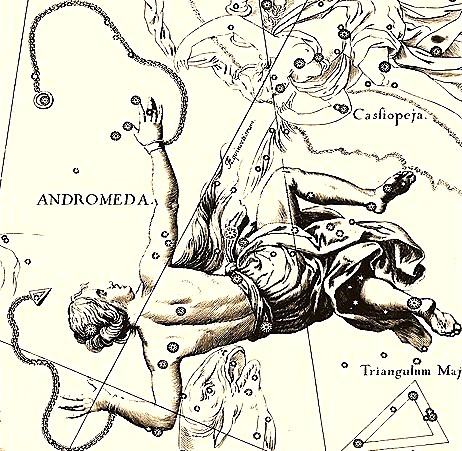
Part 4:
The Valkyrie Brynhild —
a reframed mermaid myth?
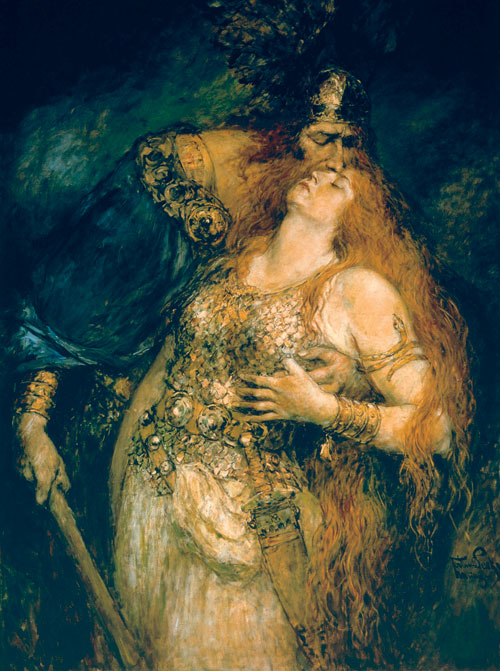 |
Ferdinand Leeke
In light of the investigations above, it might also be fruitful to examine Brynhild, the maiden who plays a fatal role in the life of Sigurd/Siegfried. Her appearances in the texts are very confusing and appear to contain contradictions.
I will show that she too may have strong connections to the constellations Capricorn and Andromeda and that this may aid our understanding of her figure. I would like to start with the ‘valkyrie-tradition’. We find this tradition in the Fafnismal, Sigrdrifumal, Snorri Edda and Völsunga Saga. Actually all of them are very similar. Let me focus first on the Snorri Edda. Skáldskaparmál 40 contains a very short summary of how Sigurd met Brynhild the first time, but exactly this makes the story interesting:
| Þá gekk Sigurðr til
Regins ok drap hann, en síðan til hests síns, er Grani heitir,
ok reið til þess, er hann kom til bóls Fáfnis, tók þá gullit ok
batt í klyfjar ok lagði upp á bak Grana ok steig upp sjálfr ok
reið þá leið sína... |
“Then Sigurdr went over to Reginn and slew him, and thence to his horse, which was named Grani, and rode till he came to Fáfnir's lair. He took up the gold, trussed it up in his saddle-bags, laid it upon Grani's back, mounted up himself, and then rode his ways…. |
| Þá reið Sigurðr, til þess er hann fann á fjallinu hús. Þar svaf inni ein kona, ok hafði sú hjálm ok brynju. Hann brá sverðinu ok reist brynjuna af henni. Þá vaknaði hon ok nefndist Hildr. Hon er kölluð Brynhildr ok var valkyrja. Sigurðr reið þaðan ok kom til þess konungs, er Gjúki hét. | "Then Sigurdr rode on till he found a house on the mountain, wherein a woman in helm and birnie lay sleeping. He drew his sword and cut the birnie from her: she awoke then, and gave her name as Hildr: she is called Brynhildr, and was a Valkyr. Sigurdr rode away and came to the king who was named Gjúki.” |
Let’s apply an astronomical interpretation:
First Sigurd slew the dragon Fafnir (Serpens) and his brother the dwarf Regin. Sigurd takes his horse Grani (the equine part of Sagittarius) and loads it with treasures (the teapot asterism in Sagittarius). This treasure is referred to as the Nibelung hoard, and rightfully belongs to three brothers, the sons of Allvaldi, Olvaldi or Ivaldi. Artisans of giant blood.
Sigurd then seeks to find Brynhild—but where to look? If we recollect the descriptions of the mermaid and raue Else in the Wolfdietrich poems, we find some striking similarities. In all cases, it is not as obvious that he encounters a beautiful woman. Sometimes the mermaid is clad with scales, raue Else seems to have hairy skin, and Brynhild wears a byrnie (chest armor) so that she looks like a man.
It is the presence of the hero which makes her transform into a comely woman. The mermaid strips off her scales and Sigurd cuts the (scaly?) byrnie off of her body. It would seem that the scaly part of the Goat-fish Capricorn was transformed into a byrnie. Like the mermaid and Babehilt, Sigurd very soon travels further and meets Gjuki (Cepheus) and Grimhild (Cassiopeia) and is seen in the sky as Perseus next to Grimhild’s daughter Gudrun (Andromeda).
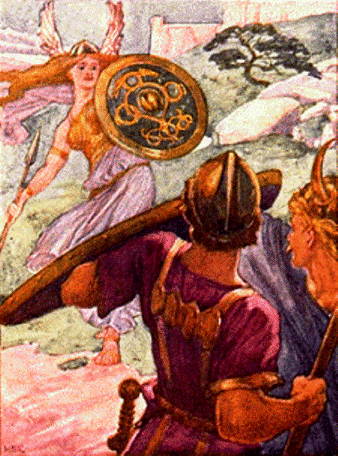 |
Sigurðr reið upp á Hindarfjall ok stefndi suðr til Frakklands. Á fjallinu sá hann ljós mikit, svá sem eldr brynni, ok ljómaði af til himins. En er hann kom at, þá stóð þar skjaldborg ok upp ór merki. Sigurðr gekk í skjaldborgina ok sá , at þar lá maðr ok svaf með öllum hervápnum. Hann tók fyrst hjálminn af höfði hánum. Þá sá hann, at þat var kona. Brynjan var föst sem hon væri holdgróin. Þá reist hann með Gram frá höfuðsmátt brynjuna í gögnum niðr ok svá út í gögnum báðar ermar. Þá tók hann brynju af henni, en hon vaknaði, ok settist hon upp ok sá Sigurð ok mælti:
Sigurd rode up on Hindarfjoll and turned southward toward the land of the Franks. On the mountain he saw a great light, as if fire were burning, and the glow reached up to heaven. And when he came thither, there stood a tower of shields, and above it was a banner. Sigurd went into the shield-tower, and saw that a man lay there sleeping with all his war-weapons. First he took the helm from his head, and then he saw that it was a woman. The mail-coat was as fast as if it had grown to the flesh. Then he cut the mail-coat from the head-opening downward, and out to both the arm-holes. Then he took the mail-coat from her, and she awoke, and sat up and saw Sigurd, and said:
| 1."Hvat beit
brynju? Hví brá ek svefni? Hverr felldi af mér fölvar nauðir?" |
1. "What bit
through the byrnie? how was broken my sleep? Who made me free of the fetters pale?" |
|
Hann svaraði: |
He said: "2. Sigmund's son, | with Sigurth's sword, That late with flesh | hath fed the ravens." |
Sigurðr settist niðr ok spyrr hana nafns. Hon tók þá horn fullt mjaðar ok gaf honum minnisveig:
Sigurd sat beside her and asked her name. She took a horn full of mead and gave him a memory-draught.
Horn in hand, he sings the famous hymn:
| 3. "Heill dagr!
Heilir dags synir! Heil nótt ok nift! Óreiðum augum lítið okkr þinig ok gefið sitjöndum sigr! |
3. "Hail, day! | Hail,
day's sons! And night and her kinswoman! With loving eyes, look upon us and give sure victory!" |
| 4. Heilir æsir! Heilar
ásynjur! Heil sjá in fjölnýta fold! Mál ok mannvit gefið okkr mærum tveim ok læknishendr, meðan lifum." |
3. "Hail gods! |
Hail goddesses, Hail all the generous earth! Give to us wisdom and goodly speech, and healing hands, while living." |
Although Brynhild bears a different name, her character is reminiscent of the pair ‘ raue Else’ and Sigeminne. He finds her engulfed in flames. She lies behind a wall of burning fire. This reminds me of the constellation Ara, responsible for the trail of smoke known as the Milky Way. Only with his horse Grani (the horse portion of Sagittarius) can this inferno be crossed. That Sigrdrifa taught him wisdom may refer to Mimir’s well, the fountain of wisdom. This well is associated with the water pouring out of the urn of Aquarius. At the same time this is the mead of poetry and Hymir’s brewing kettle.
The hindarfjoll is a reference to the Great Square of Pegasus linking her already with Andromeda. This provides a link to the references from the Nibelungenlied where Brünhild appears as ‘the lady of the sea’ (Nibelungenlied, manuscript C, chapter 6)
In the Nibelungenlied, Brünhild is introduced as a beautiful and very powerful queen ruling over a land beyond the sea:
Ez was ein kuniginne gesezzen vber se
ir geliche enheine man wesse ninder me
div was vnmazen schoene vil michel was ir chraft
The land she rules is named Island or Isenstein. It is Siegfried who defeats Brünhild not King Günter. I would associate Brynhild with Andromeda, Siegfried with Perseus and Isenstein with the Great Square of Pegasus in the “sea area” of the sky. (Nibelungenlied, manuscript C, chapter 8).
In chapter 8 we find, surprisingly at this point in the narrative, an adventure of Siegfried in the land of the Nibelungs. He arrives there with a ship (Argo Navis), defeats a gigantic doorkeeper (Orion) and the dwarf Alberich (Capella/Auriga), gets an army of Nibelungs and returns by ship (Corona Australis?) to Isenstein (Great Square of Pegasus).
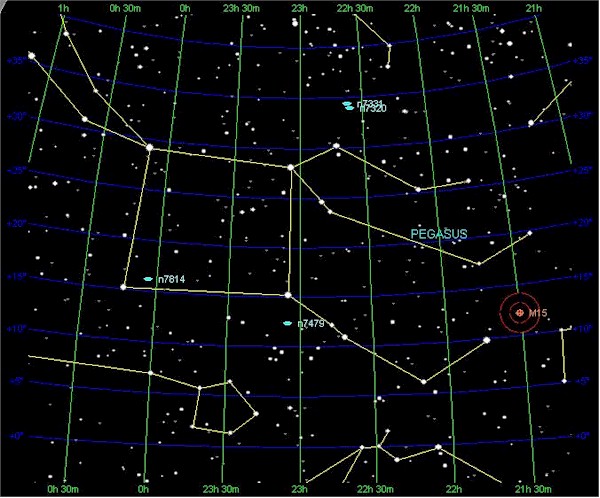
Part 5:
Saegard - “Earth out of the Sea”
The home of Brynhild bears different names in the sources. In the Nibelungenlied it is called Isenstein or Island, in several other poems the Hindarfjall. Interestingly in Thidrekssaga, it is called Saegard, the castle in the sea. This perfectly fits the description from the Nibelungenlied: Ez was ein kuniginne gesezzen vber se, ('a queen dwelt over the sea'). In her first appearance in Thidrekssaga, Brynhild is mentioned in connection with Studas, having a son with the same name, later called Heimir. Studas is famous for his horses.
This story makes perfect sense analysing it astronomically:
Brynhild as valkyrie being identical with Capricorn, the Goat-fish, located directly after Sagittarius/Heimir, the horseman, sitting on his horse Rispa. Saegard is identical to the Great Square of Pegasus surrounded by Pisces, the two fishes. As ruler of this land Brynhild is in her dual nature Andromeda. The name Saegard (‘Sea-gard’) connects the location to Sealand, the home of the giant Vadi and especially to his son Velent. Vadi has been the son of a mermaid (compare Norse Mythology) and his grandson Vidga/Wittege is jumping according to the poem Rabenschlacht on the escape of Dietrich into the sea where his grand-grandmother, the mermaid Waghild (‘Battle-wave') takes care of him. We can connect this mythical Saegard and Sealand also with the description of the new earth in Völuspá 59:
|
Sér hon upp koma |
‘She sees coming up a second time, Earth out of ocean, eternally green; The waterfall plunges, an eagle soars over hunting fish on the mountain.’ (Carolyne Larrington tr., 1996) |
Also Völuspá is describing the moment when the asterism of the Great Square of Pegasus rises from the ‘water region’ in the sky. It mentions the same waterfall, the water pouring out of the urn of Aquarius playing also an important role as fountain of youth, source of mead/wisdom or box with healing balm in the tales discussed in the previous posts.
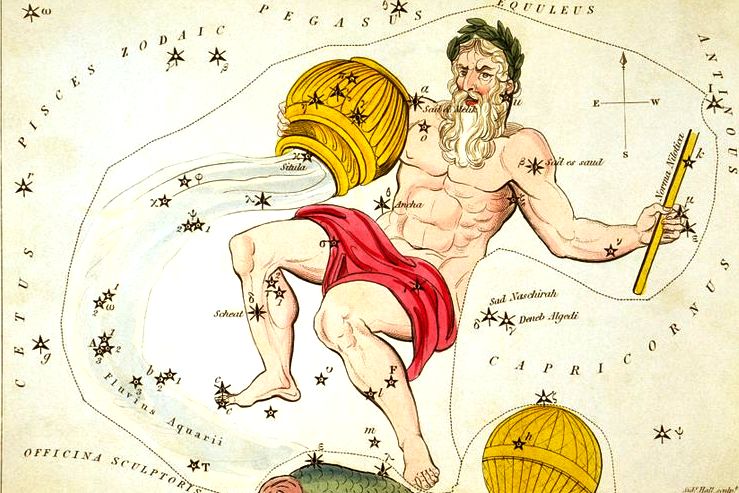
Aquarius the Waterbearer